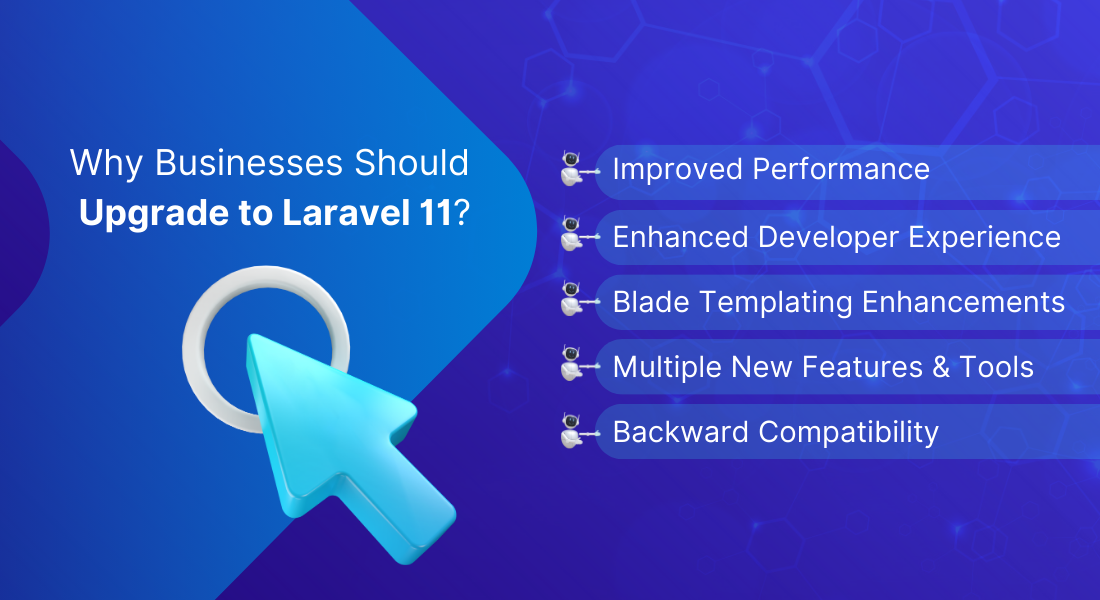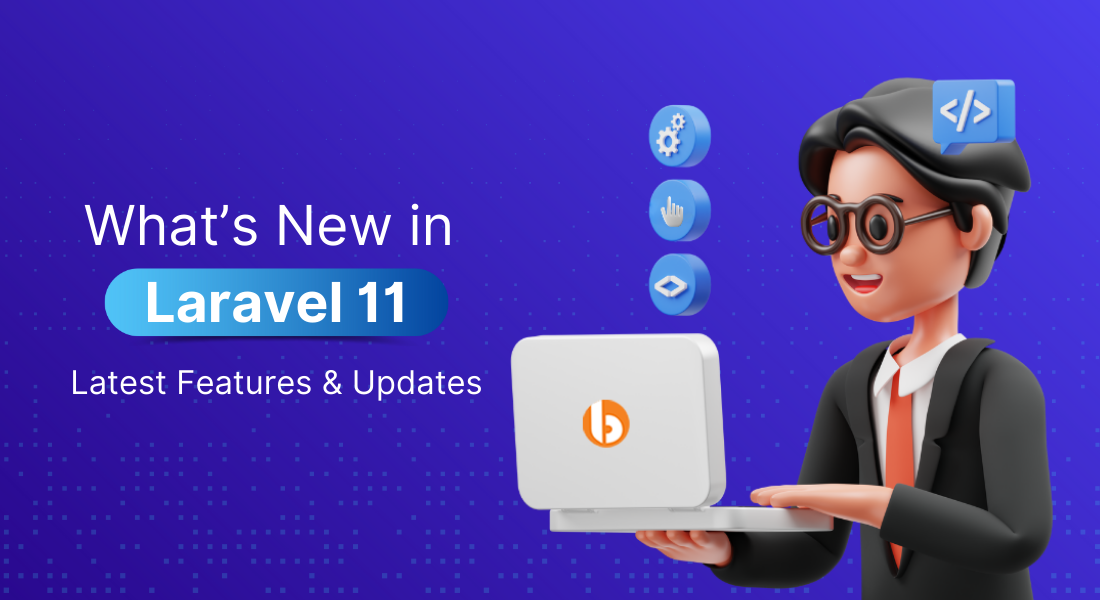| Version | PHP | Release | Bug Fixes Until | Security Fixes Until |
| 10 | 8.1 | February 14, 2023 | August 6, 2024 | February 4, 2025 |
| 11 | 8.2 | Q1 2024 | August 5, 2025 | February 3, 2026 |
Posted on November 27, 2023
By Divya Sharma


Quick Summary:
Laravel is the knight in shining armor for business owners prioritizing security for their web application development. Respecting this factor, the core team at Laravel is ready with another bombastic release of the renowned PHP web application framework, Laravel 11. So, here we are again to update you with the latest facts about What’s New in Laravel 11, along with the latest updates and features that you should look forward to for your business. Also, these factors will help you take the final stand if you should upgrade your existing Laravel to the latest Laravel version.
Referring to the latest update on the official website of Laravel, the Support Policy mentions that the latest version of Laravel 11 release date is on February 6, 2024, as we know that the Laravel core team follows the Semantic Versioning methodology that entails that the major updates to the framework are released once a year during the first quarter. However, it doesn’t mean your existing applications should be updated immediately to the latest Laravel version.
The Laravel framework was last released (LTS or Long Term Support) in version 6, but each major version possesses two years of updates; this enables enough time to get your existing codebase in check and upgrade it accordingly. According to the official Laravel documentation, Laravel 10 will receive bug fixes until August 6, 2024, and security fixes until February 4, 2025.
| Version | PHP | Release | Bug Fixes Until | Security Fixes Until |
| 10 | 8.1 | February 14, 2023 | August 6, 2024 | February 4, 2025 |
| 11 | 8.2 | Q1 2024 | August 5, 2025 | February 3, 2026 |
The team at Laravel understands the importance of the latest features and updates being introduced within the system. However, they strive to deliver the best to the developers and the business owners. This is why using the latest version of the framework or its components is always preferred. The same is the case with the latest Laravel v11, which has many updates that can benefit your business under several heads. Let’s proceed with what Laravel 11 has with this year’s latest updates.
The first and foremost change that Laravel version 11 will bring is dropping the support for PHP 8.1. The reason is that the PHP 8.2 will be fully established when Laravel 11 is up for use, and the PHP 8.3 will also be stable. Therefore, with 2 upgraded versions running within the market, the need for an older version, PHP 8.1, is unnecessary. However, again, it is not a mandate to upgrade to the latest version instantly, but you can take a thorough testing approach. You can update the existing applications gradually, but upgrading to the latest version is a great choice.
Laravel 11 possesses a slimmer application skeleton. The intent here is to involve less boilerplate code to deal with. This approach will benefit the business owners and developers to deal with less code, leading to faster development. Talking about the changes made in-depth, they are all as follows:
The core intent behind this pull request is to replace the current dd and dump methods in most Laravel classes, and it will introduce a new Dumpable trait as well. Also, the trait enables Laravel users and package authors to include debugging methods easily within their class by utilizing this trait. Let us take a glimpse of an example to use it:
Also, this pull request is specifically intended for Laravel 11.x as it requires modifications to the signature of several methods. For consistency across the entire codebase, adding the …$args to the debugging methods was added. However, it is still preferred for the Laravel 11.x version.
In the latest version of Laravel, Model casts are now defined as a method instead of a property. When defined as a method, it enables performing other things, such as calling other methods directly from the casts.
Generally, Laravel requires declaring attribute casting in an eloquent model as given below:
However, with Laravel 11 you can easily define your casting through a ‘casts()’ methods in your model that offers you a chance to use static methods from class doing the casting as illustrated below:

class User extends Model
{
protected function casts(): array
{
return [
'foo' => AsCollection::using(FooCollection::class),
];
}
}
Also, you can now specify your casts as an array, as given below:

class User extends Model
{
// Even in the old $casts property!
protected $casts = [
'foo' => [AsCollection::class, FooCollection::class],
];
protected function casts() : array
{
return [
'foo' => [AsCollection::class, FooCollection::class],
];
}
}
The ‘casts()’ method is prioritized over the ‘$casts’ property.
Also, these changes are non-breaking, which will not affect the current code when you upgrade to Laravel 11.
The older versions of Laravel possessed multiple config files, and Laravel v11 has come up with these files removed and all the config options being cascaded down. The ‘.env’ has been expanded to include all the options you want to set or configure.
Further, pairing with Laravel 11 comes with a completely new ‘config:publish’ command that enables you to bring back any config that you need. And, even after bringing them back, the new cascade feature enables you to remove every option you don’t want to customize, thereby ensuring a more streamlined and tailored configuration experience. Considering a common example, running ‘artisan config:publish database‘ generates a dedicated database config. File, precision, and organization at ease.

// To publish all the config files php artisan config:publish // Specific config file php artisan config:publish database
In Laravel v11, when creating a new Laravel application, the default migrations from 2014 and 2019 will undergo a significant reorganization. Instead of being spread across multiple migration files, these migrations will be consolidated into two files only.
This will allow the developers initiating a new Laravel project to have a cleaner and more streamlined database/migrations directory, enhancing the overall development experience and project maintainability.
Hire Laravel Developers with industry-wide experience to build next-gen Laraval solutions that help you get the best out of your project.
After removing the HTTP Kernel, the Console Kernel is also removed, and in place of that, a new approach is introduced. That means in place of having a dedicated Console Kernel file, developers will be responsible for defining their console commands directly in the routes/console.php file.
The routes/console.php file traditionally defined the Artisan commands as closures will now work as the primary location for registering all console commands. This change aims to simplify the structure of Laravel applications and offer a more simplified and consolidated way to manage console commands. By removing the Console Kernel and moving the command definitions to routes.console.php, Laravel aims to streamline the application’s configuration and reduce unnecessary files. This new approach enables the developers to have a clear and centralized view of all the console commands, making it easier to manage and maintain them throughout the development process.
Considering the default setting in Laravel, there will be two route files: console.php and web.php. If you wish API routes to be included, you must opt-in by running the ‘php artisan install:api’ that will offer you the API routes file and the Laravel Sanctum functionality.
Similarly, for the websocket broadcasting, you can use the command ‘php artisan install:broadcasting.’ This command will set up the necessary files and configurations crucial for the websocket broadcasting in your Laravel applications. Collectively, these changes will contribute to a radical shift towards a more modular and customizable application structure.
Here is a list of the other probable Laravel 11 Features and Updates that we can expect in the latest version of Laravel 11.
| Laravel 11 Other Features and Updates | ||
| [10.x] Cursor pagination model casting bugfix | #46707 | Click Here |
| [10.x] Fix doc block type for dispatchAfterCommit queue property. | #46704 | Click Here |
| Add generic type hints to collections returned from Stringable methods | #46702 | Click Here |
| [9.x] withCount doesn’t use other database connection for joins when hasManyThrough | #46675 | Click Here |
| [11.x] Do not change relative path to absolute one | #46668 | Click Here |
| [10.x] Support array syntax for casts | #46649 | Click Here |
| [10.x] Add support for Attribute union return types | #46624 | Click Here |
| [10.x] Escaping functionality within the Grammar | #46558 | Click Here |
| [9.x] Return non-zero exit code for uncaught exceptions | #46541 | Click Here |
| [10.x] Configuration value injection | #46530 | Click Here |
| [10.x] Add pipe function to Process layer | #46527 | Click Here |
| [10.x] Update RedisTagSet now() to Carbon::now() | #46396 | Click Here |
| feat(sqs-fifo): add support for fifo type of sqs queue driver | #46364 | Click Here |
| [10.x] Named static methods for middleware | #46362 | Click Here |
| [10.x] Revert facade changes | #46255 | Click Here |
| [10.x] Command Input Validation | #46037 | Click Here |
| [11.x] Adds mail notifications using mailable | #45943 | Click Here |
To install Laravel v11, initially, you must specify the ‘-dev flag’ during the installation. Laravel can then be programmed to download and install only the master branch from the ‘laravel/laravel’ repository.
However, if you prefer the hands-on installation experience, then your go-to choice is a Composer.